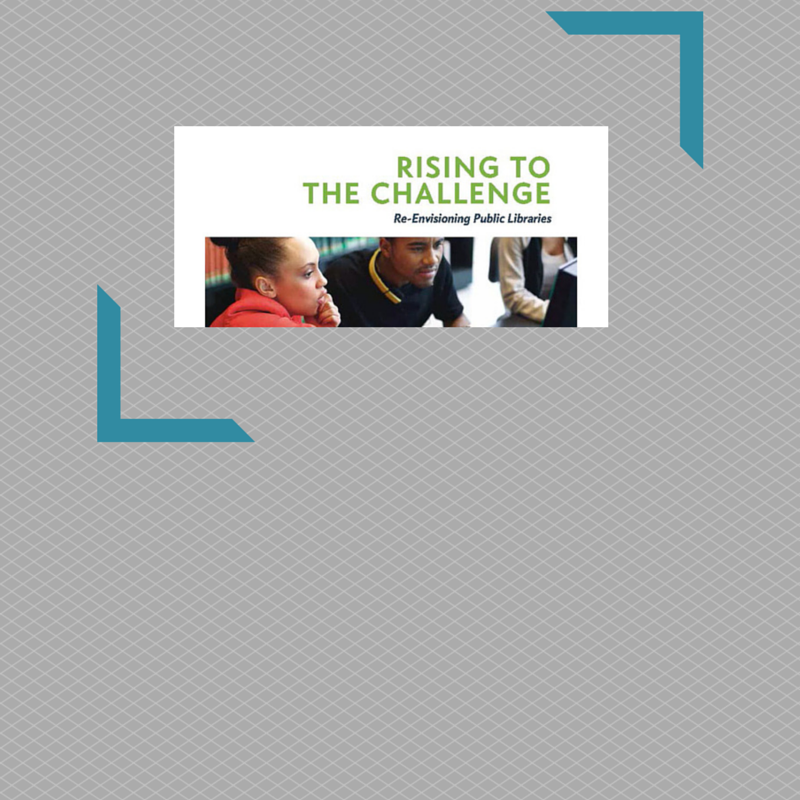Dissecting The Aspen Institute Report

In October 2014, the Aspen Institute Dialogue on Public Libraries released, Rising to the Challenge: Re-Envisioning Public Libraries. The Aspen Institute is “a multi-stakeholder forum to explore and champion new thinking on U.S. public libraries.”[1] Thirty five people from libraries, government entities, the business world, educational institutions, and community development organizations came together to discuss topics relating to public libraries in this new era.[2] The “Rising to the Challenge” report is a result of these efforts.
The report begins with a look at The Public Library in the Digital Age and shows how public libraries are poised to play a leading role in helping communities and individuals adapt to our changing world. It names three key assets that the value proposition of the public library is built around: people, place, and platform. The people focus reflects the focus shift from building collections to building human capital and puts people at the center of the library’s mission to inspire and cultivate learning, advance knowledge, and nurture and strengthen communities. In this new environment, librarians will need to be able to anticipate community needs, manage and adapt to new technology, and use data to best advantage. An intelligent community is the goal, rather than large circulation numbers.[3] For the aspect of place, more of a focus is being put on the library as the “family room of a community,” as Akhtar Badshah stated.[4] You immediately get this sense of the library as a place to simply spend time when you walk into a children’s area and find kids playing together with library toys while their parents chat, or you come upon an afternoon of chess or video games. In addition, the report notes that in an increasingly virtual physical libraries are community assets. For the library to be a platform, it has to provide a place for participation and learning, a place where assets are available. Users may customize this platform and adapt its resources to their individual needs. [5] For example, we can provide chairs and tables for business meetings and programs, as well as classes that give an overview of the business resources available to entrepreneurs and programs that can help them connect to resources to develop their businesses.
Finally, four strategic opportunities for libraries are presented.[6]
- Aligning library services in support of community goals.
- Providing access to content in all formats.
- Ensuring the long-term sustainability of public libraries.
- Cultivating leadership.
To ensure success, libraries must provide services that support community needs and not just exist as the cool new thing. They need to offer access to content in all formats by working with creators, publishers, and government. They must work toward transforming standard operations to ensure library sustainability. To be able to accomplish any of these, libraries have to actively develop leaders who can go out and become an active part of their community, learning the needs from the people.
The report also spotlights lots of exciting ideas and examples of new ways public libraries are working to meet the needs of their communities. Check it out at http://csreports.aspeninstitute.org/documents//AspenLibrariesReport.pdf .
References
[1] The Aspen Institute. “About the Dialogue.” The Aspen Institute Communications and Society. 2015. http://
[2] —. “Members of the Dialogue on Public Libraries Working Group.” The Aspen Institute Communications and Society. 2015. http://
[3] “Members of the Dialogue on Public Libraries Working Group.” The Aspen Institute Communications and Society. 2015. http://
[4] Ibid. Page 13.
[5] Ibid. Pages 17-18.
[6] Ibid. Page 33.
Tags: Aspen Institute, community engagement, job seekers, library facilities, library services, public librarianship, public libraries, Rising to the Challenge: Re-Envisioning Public Libraries, technology in libraries












